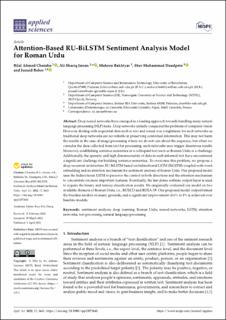| dc.contributor.author | Chandio, Bilal Ahmed | |
| dc.contributor.author | Imran, Ali Shariq | |
| dc.contributor.author | Bakhtyar, Maheen | |
| dc.contributor.author | Daudpota, Sher Muhammad | |
| dc.contributor.author | Baber, Junaid | |
| dc.date.accessioned | 2023-01-20T09:22:21Z | |
| dc.date.available | 2023-01-20T09:22:21Z | |
| dc.date.created | 2022-06-09T12:36:27Z | |
| dc.date.issued | 2022 | |
| dc.identifier.citation | Applied Sciences. 2022, 12 (7), . | en_US |
| dc.identifier.issn | 2076-3417 | |
| dc.identifier.uri | https://hdl.handle.net/11250/3044866 | |
| dc.description.abstract | Deep neural networks have emerged as a leading approach towards handling many natural language processing (NLP) tasks. Deep networks initially conquered the problems of computer vision. However, dealing with sequential data such as text and sound was a nightmare for such networks as traditional deep networks are not reliable in preserving contextual information. This may not harm the results in the case of image processing where we do not care about the sequence, but when we consider the data collected from text for processing, such networks may trigger disastrous results. Moreover, establishing sentence semantics in a colloquial text such as Roman Urdu is a challenge. Additionally, the sparsity and high dimensionality of data in such informal text have encountered a significant challenge for building sentence semantics. To overcome this problem, we propose a deep recurrent architecture RU-BiLSTM based on bidirectional LSTM (BiLSTM) coupled with word embedding and an attention mechanism for sentiment analysis of Roman Urdu. Our proposed model uses the bidirectional LSTM to preserve the context in both directions and the attention mechanism to concentrate on more important features. Eventually, the last dense softmax output layer is used to acquire the binary and ternary classification results. We empirically evaluated our model on two available datasets of Roman Urdu, i.e., RUECD and RUSA-19. Our proposed model outperformed the baseline models on many grounds, and a significant improvement of 6% to 8% is achieved over baseline models. | en_US |
| dc.language.iso | eng | en_US |
| dc.publisher | MDPI | en_US |
| dc.rights | Navngivelse 4.0 Internasjonal | * |
| dc.rights.uri | http://creativecommons.org/licenses/by/4.0/deed.no | * |
| dc.title | Attention-Based RU-BiLSTM Sentiment Analysis Model for Roman Urdu | en_US |
| dc.title.alternative | Attention-Based RU-BiLSTM Sentiment Analysis Model for Roman Urdu | en_US |
| dc.type | Peer reviewed | en_US |
| dc.type | Journal article | en_US |
| dc.description.version | publishedVersion | en_US |
| dc.source.pagenumber | 24 | en_US |
| dc.source.volume | 12 | en_US |
| dc.source.journal | Applied Sciences | en_US |
| dc.source.issue | 7 | en_US |
| dc.identifier.doi | 10.3390/app12073641 | |
| dc.identifier.cristin | 2030473 | |
| cristin.ispublished | true | |
| cristin.fulltext | original | |
| cristin.qualitycode | 1 | |

